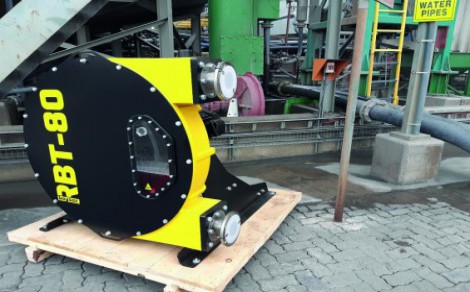- Home » Editorial » Hydraulics
Peristaltic pump for the transfer of mining slurry

The mining process generates a waste product that is a mixture of ores and water, typically coal or iron. This waste product is called tailings and must be transferred down a pipeline to a tank where the water is separated.
A coal mine in South Africa was having difficulty with this exact process and required a reliable pump to transfer their waste product efficiently. Pumps they had installed previously were wearing rapidly and were prone to leakage from the mechanical seal area. The solids in the slurry are extremely abrasive and standard centrifugal pumps become damaged very quickly, particularly the impeller, casing and mechanical seal.
In additional to this, maintenance was a long, complicated and costly process. They were required to stock numerous different spare parts in large quantities and maintenance had to be performed by specialist engineers located offsite. The ideal solution for this customer was an easy to maintain seal-less pump that did not rely on the mechanical seal for fluid containment. A pump is only as strong as its weakest part, and this is typically the mechanical seal.
North Ridge Pumps is experienced in dealing with difficult applications such as this and the company considered that one of its peristaltic pumps was the ideal solution. North Ridge Pumps believes a peristaltic pump is an excellent design for these types of applications as the only component that comes into contact with the fluid is a rubber hose located inside the pump casing. A gear box is installed between the pump and motor that decreases the pump speed, this slower and gentler pumping action reduces the effects of abrasion significantly. Chemical compatibility with the slurry was checked, resulting in a natural rubber internal hose being selected.
Reversible
Peristaltic pumps are capable of handling viscous fluids and solids as large as the internal diameter of the hose, they are also highly unlikely to clog. They are also reversible, meaning if clogging does occur, the pump can be operated the opposite way to clear any blockages in the pipework. A hose leakage detector was also specified for this customer as the pump is often unmanned, this sensor detects if the internal hose is leaking due to damage, this then signals the operator via a control panel and is an early indication of any issues.
The operation of this type of pump is unique to other pump designs. The shaft is connected to a rotor system called a shoe or roller. The shoe/roller rotates and squeezes the rubber hose, forcing the fluid through the hose at pressure. The hose is the only wearing part in the pump and is very easy to replace when it is worn. Due to the absence of a mechanical seal that normally requires lubrication, peristaltic pumps can run dry without the presence of fluid indefinitely, they can also self-prime from dry up to 9 metres.
Versatile
This range is versatile and suitable for a wide range of specialist applications. The pumps are available in various sizes and speeds, various hose materials and the largest model can achieve flow rates up to 36m³/hr and pressures up to 15 bar. The largest model within our peristaltic pump range can transfer fluid viscosities up to 50,000 cp.
North Ridge Pumps reports that this mine now has a reliable and effective pump installed for its slurry process. Downtime and maintenance have been reduced significantly; consequently, they are saving thousands of pounds in maintenance costs. Only a spare hose and silicone grease are required to be kept in stock, and with minimal training, hose replacement can be performed by their onsite engineers the same day.
The specifications of the pump that was installed for this application are:
• Peristaltic pump
• Model: RBT-80
• Pump connections: DN80
• Hose Material: Natural rubber NR
• Rotor system: Shoes
• Flow rate: 16000l/h
• Head: 10m
• Motor speed: 23rpm
www.northridgepumps.com/c_199_peristaltic
-
PPMA 2025
23 September, 2025, 9:30 - 25 September, 2025, 16:00
NEC, Birmingham UK -
Advanced Engineering Show 2025
29 October, 2025, 9:00 - 30 October, 2025, 16:00
NEC, Birmingham UK










